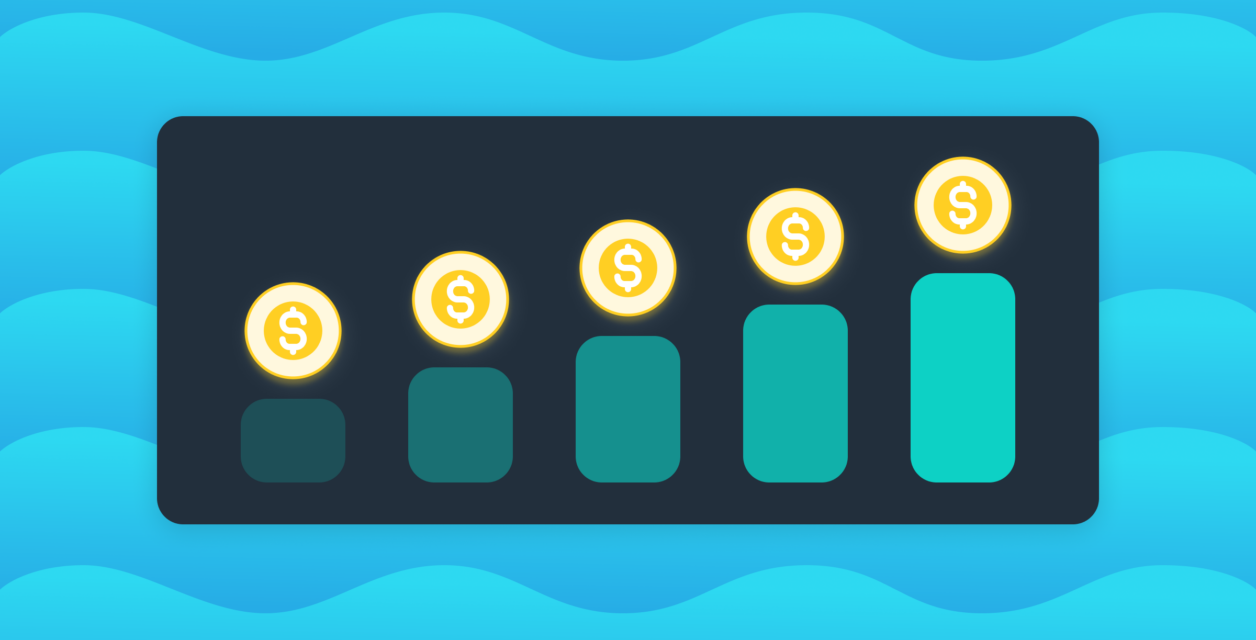According to data provided by partners at TripShock!, the bookings for tourist destinations within American South are booming for watersport tour operators providing jet ski and pontoon boat rental activities. The thing is, international vacationers will be opting for a domestic destination this year. It looks like the upcoming season is going to be the BEST in the industry history. Let’s make sure that you are well-prepared, your prices are appropriate, your bookings do not explode, and you can accommodate everyone.
First off, let’s start with the definition of pricing. “Pricing is the process whereby a business sets the price at which it will sell its products and services and can be a part of the business's marketing plan. In setting prices, the business will take into account the price at which it could acquire the goods, the manufacturing cost, the marketplace, competition, market condition, brand, and quality of product.”. So what does it mean for watersport tour operators? Let’s take a look at each price-setting aspect and find out if you are charging enough.
Tour Operators’ Price-Setting Factors
Manufacturing Cost
Your manufacturing costs, or business costs, are likely to include the following:
- Lease – Dock/Slip Rent
- Insurance
- Equipment Purchases
These constitute a significant part of your initial investment and are one of the five things you need to know before starting your watersport business.
Marketplace
Do you consider your location perfect for running your watersport operations? Are you able to identify your customer profile? What is your target age bracket? Are your customers senior citizens or youth? Is watersport a big thing in the area of your operations, like, say, in Destin, FL, where WaveRez headquarters is located, or do you operate at a small lake like Lake Maumelle in AR, where watersports still exist but just not as big? Those are some of the important questions you want to ask yourself when studying your marketplace.
Another thing to consider is figuring out if your destination is a vacation spot. To determine this, form a habit of asking your customers how long they are in town and where they come from. It may even be that new flights were launched to your destination. For example, Southwest recently announced that they will continue the new flight binge by adding 2 more destinations. That way, the marketplace will continue growing, thus bringing in new demand. Ultimately, it will be your job as a tour operator to ensure it is met.
Competition
Competition is the rivalry between companies selling similar products and services. The usual goal of competitive businesses is achieving revenue, profit, and market share growth. Additionally, the marketplace is an important indication of how competitors price their services in the area.
If you are running a jet ski rental business, consider other rental companies, such as boat, kayak, and SUP rentals, as your competitors. See why jet ski rental companies need to consider competition closely.
Market Condition
In pandemic times, it can be argued that market conditions are unstable since U.S. consumer spending decreased because of coronavirus. However, the observations also show that there have been improvements in recovering it. Traveling as usual remains challenging for vacationers, but it actually opens up new opportunities for tour operators. According to flight searches, Americans want to travel domestically in 2021, specifically to watersport destinations, such as Key West, FL, and St. Thomas, U.S. Virgin Islands.
Brand
Your brand appearance will identify who you can go after and who you should stay away from. You can base strengths/weaknesses in running your business on multiple factors. Here are the major ones:
- Are you running your business solo or with a partner? If you do the former, but consider changing it to the latter, here is what you can do to find the right partner for your watersport business.
- Do you address the safety of your operations adequately? Not addressing the safety of your business is the reason why many watersports operators fail.
- Determine where your brand is heading. Check out your reviews to see what your customers appreciate and the improvements they recommend. This information will help you strategize your pricing. For example, your customers might appreciate your unique tour customizations for families with kids that your local competitors don’t offer. In that case, you can consider charging higher prices since it makes your brand strong in the area.
Quality of Product
Are you running your watersport operations on a well-maintained dock? Do you rent used or new equipment? It is absolutely okay if you notice issues here and there. However, what is not okay is when you promote your boats as new when they are not. Misleading customers leads to difficult situations with them which you do not want to happen.
Additionally, keep in mind that if you started running your business with new equipment, it would depreciate over time. What you wanna do off-season is checking your inventory and deciding whether you should replace it or adjust prices accordingly.
Watersport Pricing Strategies
Now that we were able to figure out what forms prices, let’s explore when the price should be increased and when it should be decreased.
Margin, Market, Movement Pricing Strategy
WaveRez CEO Greg Fisher, in his podcast show, claims that margin, market, and movement should be 3 key principles of pricing. We broke down each of them below so you can see where you can push harder.
Margin
Figure out the cost for each of your trips, and add the profit you want to make on the trip. The cost of your trip can be very individual based on many details, for example, how your tour is customized, or how much fuel you or your customers usually use.
Market
See if your prices are adequate to the market of your operations. Say, if you are charging $200 and the market is $300, then it might be okay to charge higher. However, if it is the other way around, see if you can upgrade the service, for example, by having collaboration with other organizations, or because you offer new equipment vs. used.
Movement
This is related to the dynamic pricing idea, which we discuss as a separate pricing strategy down below.
Dynamic Pricing Strategy
Also called demand pricing, surge pricing, or time-based pricing, dynamic pricing is when customer demand dictates where prices fluctuate. Some of the ways for tour operators to test out this strategy can include success packages. For example, you offer parasailing at your location and know that it will be somewhat windy tomorrow. This is likely to cause a demand increase for it and a decrease in other activities, such as snorkeling because it is not the best weather. That is when dynamic pricing can kick in full swing. In fact, WaveRez software’s algorithms can figure this out for you; schedule a free demo with our sales team and tell them you heard about this feature by reading this blog.
Competition-Based Pricing Strategy
We have already highlighted why it is crucial to account for competition in your area. As far as the competition-based pricing strategy goes, let’s look at Lake Havasu in Arizona, which is highly saturated with jet ski rental companies. When following this pricing strategy, you can look into how much your competitors charge for their rentals and any differences in their offerings. You can even disregard consumer demand here and just pick and choose one of the following actions with a price:
- Slightly lower it compared to your competition
- Keep it the same as your competition
- Make it slightly higher compared to your competition
Remember that you need to base your numbers game on the going rate pricing, trying to avoid price wars.
Freemium Pricing Strategy
It is not a very popular pricing strategy among watersport operators and often undervalued, but we believe it is worth considering. Freemium is the combination of words “free” and “premium.” Freemium pricing is when you offer a basic version of your service, hoping that your customers will pay to get extra perks. For example, you can offer a free dock jumping activity for the kids waiting for their parents to come back or rent goggles and masks to make a service more enjoyable.
High-Low Pricing Strategy
Not always applicable in tour operators’ context, but it can still be relevant. Discount pricing strategy, which is another name for it, is when your product or service drops in relevance or novelty by some point. For example, you already got a new fleet for a new season, but you decided to give your old equipment a final opportunity to serve your customers. You cannot charge the same when renting 2015 Yamaha WaveRunners together with 2020 Sea-Doo; it would just be unfair to your customers due to depreciation that has occurred to the former. So long as it is still safe to operate older equipment, you can still rent it to the customers, but just do it at a reasonable price.
Skimming Pricing Strategy
Similar to the High-Low Pricing Strategy, the skimming pricing strategy is when you charge the highest possible price for a service, lowering it gradually over time. If you are new to watersports, this year can be an excellent opportunity for you to try this strategy due to tourists’ preference to travel domestically in 2021. For example, you may start offering cage diving at your location with the price set very high because no other tour operators offer it in your area. However, over time you will notice that it will start losing its attractiveness because it will be tried by many people and stop being unique. This is why it will make sense to discount it gradually each new season.
Penetration Pricing Strategy
The opposite of the skimming pricing strategy, the penetration pricing strategy is when you start your business with very low prices, effectively drawing customers’ attention. Many tour operators would agree this pricing model is hardly sustainable, just like going mobile, which we discuss when arguing how to find a perfect location for your business. Unlike the skimming pricing strategy, the penetration pricing strategy would likely work for you in the first season.
It is also quite similar to the loss leader pricing strategy. You sell some services at a very low price, hoping that your customers will consider getting other more expensive options. For example, you know that it will be a final season for you to rent the 2015 Kawasaki Jet Ski because you already have 2021 Yamaha WaveRunners that will replace them eventually. What you can do is post low prices for renting the older PWC on your website, but once the customers arrive, you can suggest them to upgrade by paying more for renting a newer PWC.
Bundle Pricing Strategy
A bundle pricing strategy is when you have complementary products or services, which get sold at a single attractive price. It is also often seen as an alternative to selling on an à la carte basis. Some tour operators claim in our affiliate Facebook group that they figured out success packages that help them grow their business. Based on their booking information, some saw an opportunity for a flat fee to rent a jet ski one day and provide parasail tours the next day to the same customer. Some also offer all-day different water-based activities to the same group of customers who get them at a discounted price.
Value-Based Pricing Strategy
This pricing strategy requires tour operators to consistently research their customer profiles or buyer personas. For example, many families with kids visit your location, but not many senior citizens. One possible reason can be that your product is perceived as overpriced. First of all, identify the customer’s median age for a particular activity; let’s take pontoon boat rentals for this example. Once you figure this out, you can arrange a discount for pontoon boat rentals for seniors for an indefinite period. After some time, see if it makes a difference.
Psychological Pricing Strategy
Psychological pricing strategy targets your customers’ psychology to boost your sales. According to the 9-digit effect, even though your kayak rental costs, say $100, but you change it to $99.99, your customers will see a good deal simply because of the “9” in price. You can experiment with this strategy on your website by doing an A/B test with Google Optimize on all water-based activities you offer. Set kayak rental price at $99.99, canoe rental at $100, and see if former converts better than latter. You can also try a “buy one, get one 50% off” strategy, or change the font, size, and color of your pricing information, both of which were proven to be effective.
Geographic Pricing Strategy
Lastly, if you rent watersports equipment or offer splashing activities in different states or even countries, consider geographic pricing strategy. This is when you price your products or services differently based on location. To illustrate, considering that things are more expensive in MA than in FL, charging for the same conditioned SUP in both states would not make much sense.
As we mentioned above, these strategies aren’t necessarily meant to stand alone. We encourage you to mix and match these methods where applicable.
Now, let’s discuss how to apply these strategies to different business scenarios and the possible obstacles that may arise.
Frequently Occurring Business Situations and How to Respond
Now that we familiarized ourselves with pricing factors, pricing strategies, it is time to figure out the challenges that can prevent you from determining the right pricing strategy. Here are the scenarios and ways to respond, as reported by WaveRez and TripShock partners.
Bookings are booming! How do you catch the wave of leads?
Say it’s a high season, but you are unsure if you should keep prices as they are or increase them. There are several ways to capture your possible leads, as well as find out their level of activeness on your marketing channels, which, in turn, can help you determine if you should raise or decrease the price. Here are some tips that our partners found helpful.
Track User Experience on Your Website
We have already indicated that Google tools like Google Optimize can be handy for testing psychological pricing strategy. Another free tool is Google Analytics, which can tell you user behavior on your website, specifically, where your leads spend most of their time, or where their sessions get interrupted. Additionally, Google Analytics Academy provides free training to those interested in exploring these tools’ full capabilities.
Eliminate the Broken Links and Increase the Website Loading Speed
While researching your website’s user behavior, you might notice where the visitor’s sessions get interrupted. The most common reasons are broken links and slow website loading speed, as a result of which you can lose conversions and miss out on the opportunity to increase prices when needed.
Get Listed on Listing Websites
There are many websites, such as TripShock.com, where you can list your tours and activities. Known to help increase bookings, these sites’ experts help you expand your online presence by showing you how to structure your listing better, description-wise and price-wise. They use insights data, as well as trends and best-known practices.
Responding to Competitors through Price Wars
Suppose you decide that a Competition-Based Pricing Strategy might be the model you want to test for your business. In that case, you might sometimes find yourself trapped in “Price Wars”. A price war is when two or more competing companies lower the prices of comparable services to steal customers. Here are the pros and cons:
| Price Wars | |
| Pros | Cons |
| Lower prices for customers | Possible market share and profit loss when losing in price wars |
| Extra add-on services for customers | Less competition and higher prices |
| Businesses gain new customers | Fewer choices for products and services available to customers |
The watersport industry is very social by nature; many tour operators know each other well and usually would not attempt to steal customers. For that reason, we do not encourage getting involved in a price war; instead, collaborate with your competitors and adopt an idea-sharing mindset in order to improve your business. Here are some ideas to look at: how to start a watersport business, and how to negotiate your lease.
Experiment with Different Pricing Concepts
You can’t just set the prices and forget about them. Instead, try seeing if there is a way for you to adapt them according to the price-setting factors and commonly used watersport pricing strategies by keeping in mind the frequently occurring business scenarios and ways to respond. This will ensure you react to market conditions appropriately and make larger profits when running your watersport business.
While getting ready for a new season, ensure that your prices are updated. Additionally, do not forget to announce the reopening. Lastly, check out Awkward Watersport Guys Podcast episode #27, in which WaveRez CEO Greg Fisher, and his podcast partner Kevin O’neil, master captain, discuss pricing your rentals & tours, plus some chatter on dynamic pricing & Groupon.



